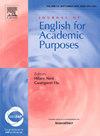中医专业多字单位
IF 3.4
1区 文学
Q1 EDUCATION & EDUCATIONAL RESEARCH
引用次数: 0
摘要
中医、中国文化、汉语都植根于中国古代哲学,相互渗透。本研究采用定量与定性相结合的语义分析方法,对中医中出现频率最高的多词单元进行识别。从中医教科书和期刊文章的语料库中开发了538个中医搭配和词汇集。这些多词单位由以下一种或多种词组成:汉语外来词(如党归)、汉语外来词加英语词(如气变换)和英语词(如肺经)。功能分类分析显示,中医多词单元主要分为诊断、治疗和理论三大类。这些结果表明,搭配和词汇束在创造中医语篇的结构和主题知识方面起着至关重要的作用,支持了先前的研究,即一些专业词汇需要组合而不是单独的词汇。本文章由计算机程序翻译,如有差异,请以英文原文为准。
Specialized multiword units in traditional Chinese medicine
Traditional Chinese Medicine (TCM), Chinese culture, Chinese language all root in ancient Chinese philosophy, and thus each of them penetrates the others. This study adopted a mixed-method approach of quantitative and qualitative semantic analysis to identify the most frequent multiword units in TCM. A list of 538 TCM collocations and lexical bundles was developed from a corpus of TCM textbooks and journal articles. These multiword units are made up of one or more of the following types of words: Chinese loan words (e.g., dang gui), Chinese loan words plus English words (e.g., qi transformation), and English words (e.g., the lung channel). A functional taxonomy analysis revealed three main categories of TCM multiword units: diagnosis, treatment, and theoretical. These results suggest that collocations and lexical bundles play an essential role in creating both the structure and subject knowledge of TCM discourse, supporting previous research which revealed that some technical words need to be seen in combinations rather than as individual words.
求助全文
通过发布文献求助,成功后即可免费获取论文全文。
去求助
来源期刊

Journal of English for Academic Purposes
Multiple-
CiteScore
6.60
自引率
13.30%
发文量
81
审稿时长
57 days
期刊介绍:
The Journal of English for Academic Purposes provides a forum for the dissemination of information and views which enables practitioners of and researchers in EAP to keep current with developments in their field and to contribute to its continued updating. JEAP publishes articles, book reviews, conference reports, and academic exchanges in the linguistic, sociolinguistic and psycholinguistic description of English as it occurs in the contexts of academic study and scholarly exchange itself.
 求助内容:
求助内容: 应助结果提醒方式:
应助结果提醒方式:


